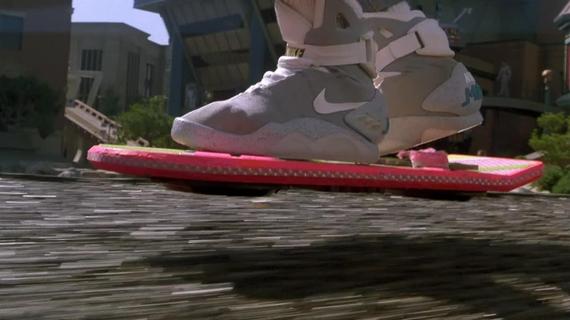My younger sister is a huge fan of Sonic the Hedgehog. As such, I've had my fair share of playing the Xbox game Sonic Riders, which involves flying through strange landscapes on various hoverboards.
Steering and dodging to collect all those little golden rings on fantastical airborne-craft always raises the same question: when can I fly a real hoverboard?
Two companies are currently working towards making this a reality. There's the well-known transporter Slide, which has been built by experts in super conductive technology in conjunction with Lexus. Utilizing high temperature superconducting blocks, the Slide achieves hovering by means of magnetic levitation. Lexus has already demonstrated their revolutionary new technology, but it comes with a catch: in order to achieve magnetic flux, the concrete beneath the board must also be lined with magnets. Not exactly an infrastructure in most sidewalks and streets.
Then there's Arx Pax, a California-based company with the single goal of developing the Magnetic Field Architecture (MFA) technology their business is based on. With their efficient transmission of electromagnetic energy, Arx Pax expanded their company with the sector Hendo Hover, which focuses entirely on designing a hoverboard. In addition to magnetic levitation like that of Lexus, Hendo also utilizes disk-shaped hover engines.
Though the science behind these boards is slightly different, there is one staggering similarity between the two: they both look like skateboards.
With such a wide range of movies, fiction, and video games involving imagined version of hoverboards, I was surprised by this analogous decision on shape. Would diverse minds and companies not draw from different sources for inspiration? There is a large selection, after all: Jim Hawkin's Solar Surfer in Walt Disney's Treasure Planet is imagined as a sail ship for the sky. The Green Goblin's Glider from Spider Man looks like anything but a skateboard. The Uglies, a young adult series by Scott Westerfeld, has hoverboards that are described as being three times the size of a skateboard. Though Sonic Riders may have a few boards constrained to skateboard models, there are also beautifully imagined hovering bikes.
Where, then, did this skateboard stereotype first arise? Was it from the famous Back to the Future II? Did Michael J. Fox gliding around on his pink, skateboard-styled craft idealize the hoverboard image? Wikipedia even acknowledges a hoverboard as a "skateboard without wheels."
Of course, given many of the associated costs with these two boards, perhaps the shape is related to function and not form. The Lexus board requires liquid nitrogen to cool off the superconducting blocks and, though liquid nitrogen is relatively cheap (only 10 or 15 cents a liter), storing the liquefied element is another job altogether (most storage freezers cost upwards of $600). A skateboard-style may seem lacking in originality, but this model is large enough to house a human without adding extra weight that would require additional superconducting blocks or liquid nitrogen. For Hendo, the disk-shaped hover engines the company employed would necessitate more power if the board were any larger (as many imagined versions are). Though Lexus has made it clear they have no plans to bring their product to marketplace (and thus there is no approximate price tag), Hendo's first few model boards were shipped for a jaw dropping 10,000 dollars.
Can you imagine what the Green Goblin's glider would cost if it existed?
Plus, with the current technology as it is, the best we can hope out of today's hoverboards is a means of entertainment at a (magnetic) skate park. We won't be using this technology to commute or head to the grocery store. They are, quite simply, hovering skateboards. That's what they are being marketed for and, naturally, they would be designed to look like skateboards.
When the day comes that hoverboards move beyond simple entertainment, maybe then we'll begin to see more futuristic versions and models.




